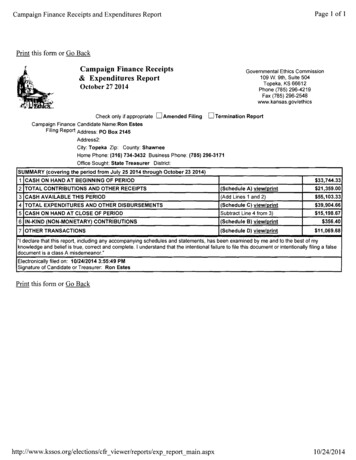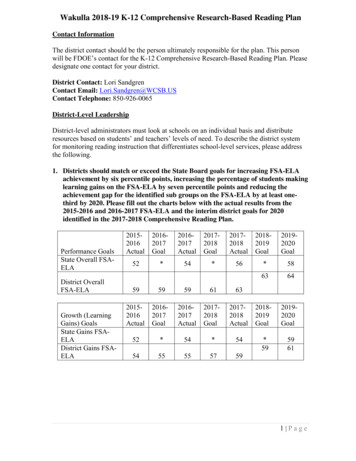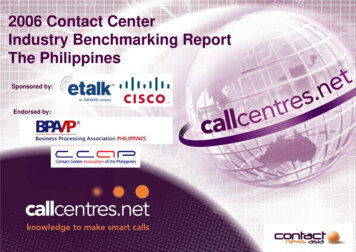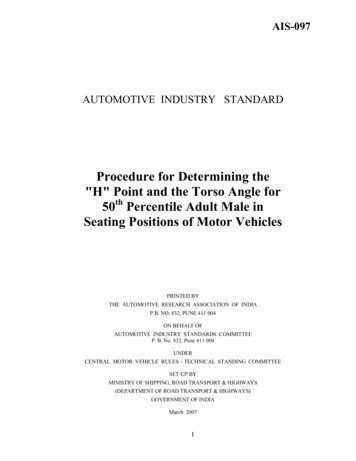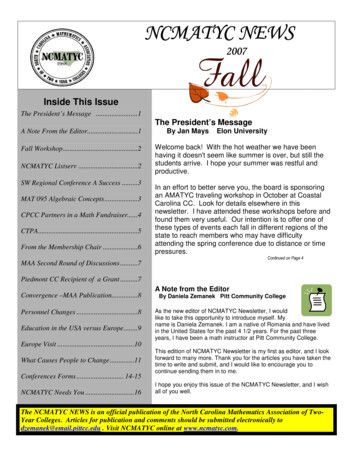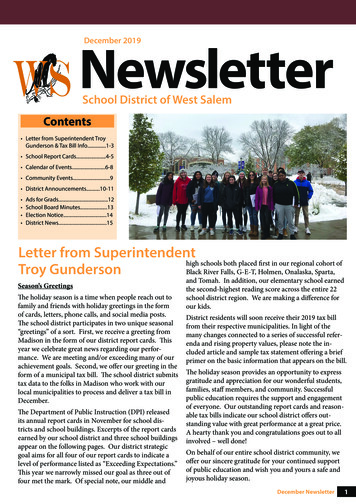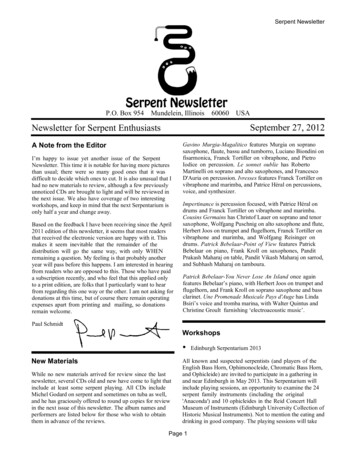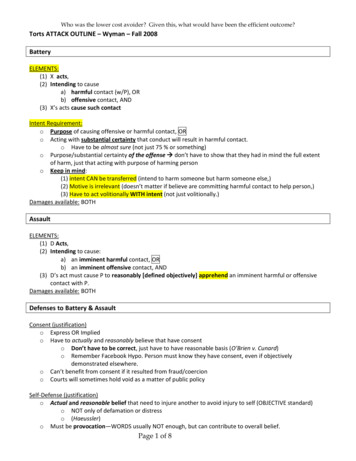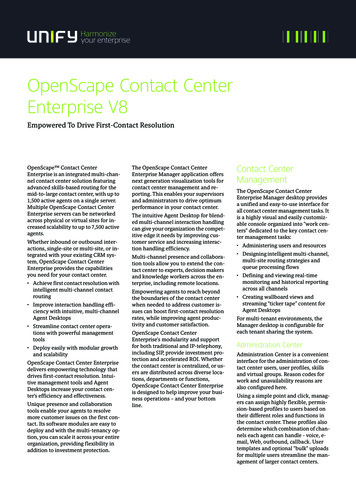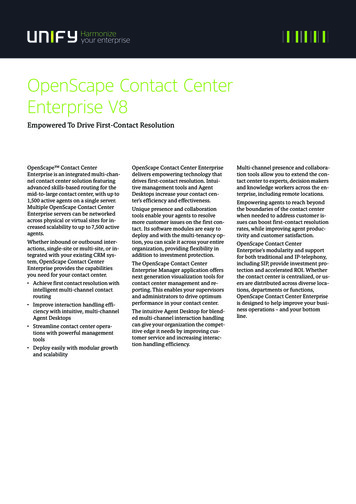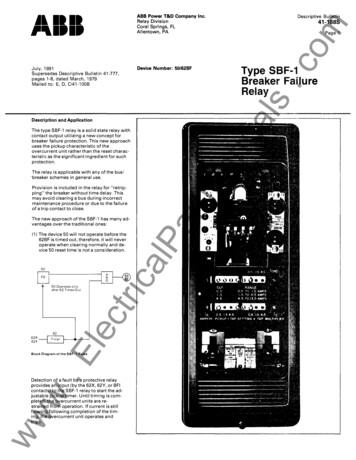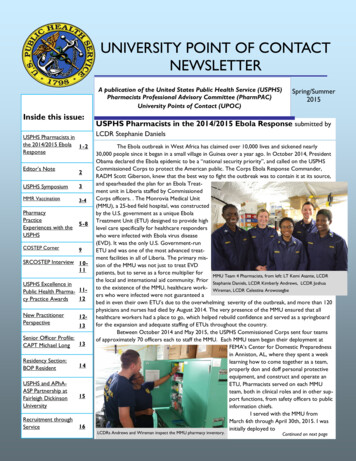
Transcription
UNIVERSITY POINT OF CONTACTNEWSLETTERA publication of the United States Public Health Service (USPHS)Pharmacists Professional Advisory Committee (PharmPAC)University Points of Contact (UPOC)Inside this issue:USPHS Pharmacists inthe 2014/2015 Ebola 1-2ResponseEditor‘s Note2USPHS Symposium3MMR Vaccination3-4PharmacyPracticeExperiences with theUSPHS5-8COSTEP Corner9SRCOSTEP Interview 1011USPHS Excellence inPublic Health Pharma- 1112cy Practice AwardsNew PractitionerPerspective1213Senior Officer Profile:13CAPT Michael LongResidency Section:BOP Resident14USPHS and APhAASP Partnership atFairleigh DickinsonUniversity15Recruitment throughService16Spring/Summer2015USPHS Pharmacists in the 2014/2015 Ebola Response submitted byLCDR Stephanie DanielsThe Ebola outbreak in West Africa has claimed over 10,000 lives and sickened nearly30,000 people since it began in a small village in Guinea over a year ago. In October 2014, PresidentObama declared the Ebola epidemic to be a ―national security priority‖, and called on the USPHSCommissioned Corps to protect the American public. The Corps Ebola Response Commander,RADM Scott Giberson, knew that the best way to fight the outbreak was to contain it at its source,and spearheaded the plan for an Ebola Treatment unit in Liberia staffed by CommissionedCorps officers. . The Monrovia Medical Unit(MMU), a 25-bed field hospital, was constructedby the U.S. government as a unique EbolaTreatment Unit (ETU) designed to provide highlevel care specifically for healthcare responderswho were infected with Ebola virus disease(EVD). It was the only U.S. Government-runETU and was one of the most advanced treatment facilities in all of Liberia. The primary mission of the MMU was not just to treat EVDpatients, but to serve as a force multiplier forMMU Team 4 Pharmacists, from left: LT Kemi Asante, LCDRthe local and international aid community. Prior Stephanie Daniels, LCDR Kimberly Andrews, LCDR Joshuato the existence of the MMU, healthcare work- Wireman, LCDR Celestina Arowosegbeers who were infected were not guaranteed abed in even their own ETU‘s due to the overwhelming severity of the outbreak, and more than 120physicians and nurses had died by August 2014. The very presence of the MMU ensured that allhealthcare workers had a place to go, which helped rebuild confidence and served as a springboardfor the expansion and adequate staffing of ETUs throughout the country.Between October 2014 and May 2015, the USPHS Commissioned Corps sent four teamsof approximately 70 officers each to staff the MMU. Each MMU team began their deployment atFEMA‘s Center for Domestic Preparednessin Anniston, AL, where they spent a weeklearning how to come together as a team,properly don and doff personal protectiveequipment, and construct and operate anETU, Pharmacists served on each MMUteam, both in clinical roles and in other support functions, from safety officers to publicinformation chiefs.I served with the MMU fromMarch 6th through April 30th, 2015. I wasinitially deployed toLCDRs Andrews and Wireman inspect the MMU pharmacy inventory.Continued on next page
Page 2S p r in g / Su mm er 2 0 1 5Continued from page 1 USPHS Pharmacists in the 2014/2015 Ebola Responseserve as a clinical pharmacist , but the pharmacy team had enough depth that I was primarily needed with the safety team in―doffing‖. Doffing encompasses the entire procedure of safely decontaminating and removing personal protective equipment(PPE). The MMU‘s doffing procedure counted 27 steps, each of which had to be performed in exact order and with great attention to detail to ensure that officers minimized their chances of contact with the potentially deadly infectious material . Doffingcoaches were responsible for spraying each officer leaving the ―hot zone‖ with chlorine spray toinactivate virus particles on their PPE, as well as coaching them through each step of the removalprocess. If I had a nickel for every time I said ―Now wash your hands again‖, I‘d probably have ahouse in Malibu. Doffing was considered to be one of the most punishing environments forwearing PPE, as the area had to be opened to the African air to allow for adequate ventilation ofthe chlorine spray— my hands would usually be sloshing in my gloves by the time I was finished.Being a doffing coach was one of the hardest and most stressful things I‘ve ever done, but it wasreally rewarding to know that my team members were safe because of the contributions I made.Liberia began to approach Ebola-free status at the beginning of April, and after our lasttwo patients were discharged, the MMU was transitioned into closing mode,. We began to refocus our mission on helping to rebuildthe capacity of the existing healthcare system through transition ofLCDR Daniels and LCDR John Mastalski our equipment and training of local healthcare workers. I helpedmy fellow pharmacists inventory and pack the pharmacy cache fordecontaminate and doff LCDR Marktransfer to the Liberian Ministry of Health, and worked with LCDRScheckelhoff and CDR Alex Brenner.Tiffany Moore, LCDR Pieter Van Horn, and LT Dan Quist to trainthe staff at ELWA Hospital on BLS and ACLS. LCDR Moore and I pieced together a functional CPRmannequin out of PPE items that were set aside for training use, and it was incredibly inspiring tosee our Liberian colleagues embrace the lifesaving principles of CPR and AED use.The MMU was officially closed on April 30, 2015, in a ceremony attended by the MMU‘s Ebola Survivors, the President of Liberia, Ellen Johnson Sirleaf, the US Ambassador to Liberia, DeborahMalic, and the US Surgeon General, VADM Vivek Murthy. Liberia was officially declared Ebola-freeon May 9, 2015, less than 10 days after the conclusion of the MMU mission. This victory was due in LT Kemi Asante inspects LCDRRanjodh Gill‘s PPE to make sure thereno small part to the incredible efforts of the USPHS officers across all four MMU teams.are no gaps.This deployment was one of the most challenging, gratifying, humbling, and rewarding experiencesof my life, and every sacrifice I made was well worth it. It would not have been possible without thesupport of the officers who remained at home, and I hope to pay forward all of the sacrifices that others have made on my behalfso that I could come home a better officer and person.Editor’s Note:Welcome to the Spring/Summer 2015 edition of the UPOC Newsletter! The UPOC newsletterhas served as a gateway for pharmacy students to learn about the roles and activities of USPHSofficers as well as for UPOC officers to share their recruitment activities. I work with a very talented group of officers who are striving to make this newsletter as relevant to pharmacy studentissues as possible.Now that you‘re on break, it‘s time to think about pursuing COSTEP positions, which are due Dec31st! In this issue, you will find pertinent information regarding Junior and Senior COSTEPS in ourCOSTEP Corner and an interview with a SRCOSTEP from the BOP. Keep this issue as a resourcecome rotations and residency time.We hope you find this edition enjoyable and informative. As always, we welcome your commentsand suggestions.Join us on Social Media!Yours sincerely,Check us out:LCDR Honeylit Cueco, PharmDhttp://www.usphs.gov/corpslinks/pharmacy
Page 3S p r in g / Su mm er 2 0 1 550th Annual USPHS Commissioned Officers Foundation (COF)Scientific and Training Symposium submitted by LCDR Matthew DuffThe United States Public Health Service Commissioned Officers‘ Foundation hosted its 50th annual Scientific and Training Symposium in Altanta, GA last week to a record attendance of USPHS officers, federal, state, and local health officials, and students. Thesymposium is a great opportunity to get continuing education credits, network with public health colleagues, participate in community service, and have a good time! This year‘s conference was the first that I have ever attended, and I had such a great experience that I found myself regretting that I hadn‘t gone sooner. Students are able to attend the USPHS Symposium free ofcharge, which is an incredible deal, especially if the conference will be in your local area.Highlights from the conference included the opening plenary session lecture given by our recently appointed 19th Surgeon General, Vice Admiral Vivek Murthy, and the closing lecture given by the Acting Assistant Secretary for Health, Dr. Karen DeSalvo.The Ebola outbreak and the USPHS response to it were also featured heavily throughout the symposium. It was particularly moving to hear the first-hand experiences of several pharmacy officerswho were part of the Team 1 deployment to Liberia, during the discussion panel on Ebola on pharmacy category day. These are truly amazing individuals and they provided an invaluable service toour country and the world.There were several opportunities to volunteer during the Symposium. I volunteered for the JOAGUniform Inspection Booth, which consisted of staffing a booth in the exhibition hall where officerscould stop by to ask any questions they had regarding uniform wear and also provided head-to-toeinspections of uniforms to ensure the officer is wearing the uniform appropriately per regulations.Without a doubt the best part of attending the symposium was socializing with fellow officers andpublic health employees. It was great to meet new friends and to catch up with friends and associates that I hadn‘t seen in years. There are always several opportunities to socialize, including theCategory Day Social and the Joint Combined Social. The Pharmacy Category Day Social this yearCAPT Dan Beck receives anwasheld at the Hard Rock Café in downtown Atlanta,Honorary Pharmacist awardand it was a great opportunity for the pharmacists atfrom Pharmacy Chieftending the conference to get together, have a fewProfessional Officer, RADMdrinks, mingle and relax.Pamela Schweitzer.There were several pharmacy students in attendance atthe conference, who had an incredible chance to meet top brass in the CommissionedCorps and to get to know PHS officers. They left with plenty of business cards andpotential connections for rotations and jobs in public health after graduation. This isan invaluable experience for any student with even the slightest interest in publichealth, JRCOSTEP or SRCOSTEP internships, or becoming a commissioned officer. Asfor me, I plan to make it to as many Symposiums as I can in the future, hopefully making it an annual tradition. Next year the Symposium will be held in Oklahoma City,Deputy Surgeon General RADM Boris LushniakMay 16-19th. I hope to see you there!announces his retirement. at the 2015 Symposium.Measles Mumps and Rubella (MMR) Vaccination submitted by LT Lysette Deshields, LCDR AshleeJanusziewicz, LT Sadhna Khatri, and LCDR Monica Reed-AsanteThe measles virus, morbillivirus, was first described in the 9th century and accounted for thousands of deaths each year. Morbillivirus, is spread primarily via coughing and sneezing. Initial symptoms include fever, cough and red eyes, however, the characteristicsymptom, a red, flat rash that covers most of the body, usually appears within a few days after the start of the initial symptoms.The virus is extremely contagious and approximately 90% of those exposed to someone with measles will get the disease themselves unless they have been vaccinated, or have had measles before. In the decade prior to the introduction of the MMR (measles-mumps-rubella) combination vaccine in the United States, it is estimated that more than three million people were infected withmeasles each year.Continued on page 4
Page 4S p r in g / Su mm er 2 0 1 5Continued from page 3 MMR VaccinationIn 1963, John Enders and his colleagues developed the firstdoubt and mistrust of some parents regarding the vaccinesmeasles vaccine, and in 1968 an improved version was de-efficacy and safety, despite its success in saving many millionsveloped. In fact, the same strain of measles used in the vac-of children‘s lives. Currently, in the United States, a multi-cine developed in 1968 is still used in the current vaccinestate measles outbreak has erupted resulting from a travelertoday, which is combined with mumps and rubellawho contracted measles overseas and spread the disease to(MMR). Since the introduction and widespread use of theothers upon their return to the United States. Most recent-MMR vaccine, measles cases in the country have decreasedly, this outbreak has been linked to substandard vaccination1by more than 99%. Additionally, the transmission of mea-compliance and has highlighted the prevalence of the anti-sles in the United States was documented as eliminated invaccination movement in the United States among vaccina-2000. Despite the success that has accompanied the intro-tion-hesitant parents. Given that unvaccinated children areduction of the measles vaccine, its introduction has alsothe population that are most at risk for contracting measles,been associated with controversial claims regarding its rolethe take home message that can be captured from this inci-in causing life altering side effects.dence is the importance of on-time measles vaccination toThe Measles Mumps and Rubella vaccine contro-prevent future outbreaks.versy began in 1998 with the publication of an article in TheIn the wake of the measles outbreak, it is impera-Lancet by Andrew Wakefield which claimed that many au-tive that we as pharmacists continue educating our commu-tism and colitis cases in children were due to the MMR vac-nity of the importance of obtaining vaccinations against mea-cine. This was widely covered by the press and as a resultsles not only to protect themselves, but to also protect oth-vaccination rates decreased significantly in the UK and Ire-ers. As pharmacists, we are in a unique position to mitigateland. This resulted in a significant increase in morbidity andconcerns and misconceptions about vaccinations. Althoughmortality due to incidences of measles and mumps. Uponmeasles is rare in the United States as a result of efforts toinvestigation, it was later found the author of the article hadpromote and administer the vaccine, the risk of importingmanipulated the evidence. As a result of his claim, manythe disease from international countries does exist. As partlarge epidemiological studies were conducted and it wasof our mission to protect, promote, and advance thejointly concluded by the Centers for Disease Control andhealth and safety of the Nation, it is our duty asPrevention (CDC), The American Academy of Pediatricspharmacists to effectively communicate to mem-and the Institute of Medicine of the US National Academy ofbers within our community the benefits of receivingScience, that there is no link between the MMR vaccine andvaccinations so that they are able to make well-Autism. In addition, the benefits of vaccination (i.e., decreaseinformed decisions.in disease incidence and prevalence) outweigh the risks ofnot vaccinating children.The debate around vaccination continued includingclaims that vaccinations containing thiomersal could be acontributing cause of autism. In the United States, thio-Our mission as public health officers is to remindthe public of the overall success and significance ofvaccination. In addition to educate the public, vaccines protect not only an individual, they protect theentire community.mersal is a mercury based preservative used in vaccines toReferences:prevent bacterial and fungal growth. Upon investigation by1. is-vac-risks.htm2. /3. /4. Boseley, Sarah (2 February 2010). "Lancet retracts 'utterly false' MMR paper". TheGuardi(London). Retrieved 14 January 2015.5. "MMR timeline". The Guardian (London). 28 January 2010. Retrieved 2010-10-28.the Institute of Medicine, World Health Organization(WHO), Food and Drug Administration and the CDC, theseclaims were proven incorrect and no evidence of harm wasreported by the use of thimerosal preservative.Unfortunately, these controversies have led to the6. Baker JP (2008). "Mercury, Vaccines, and Autism: One Controversy, Three Histories". Am J Public Health 98 (2): 244–53. doi:10.2105/AJPH.2007.113159
Page 5S p r in g / Su mm er 2 0 1 5Advanced Pharmacy Practice Experience (APPE) at WinslowIndian Health Care Center submitted by Jordan L. Wulz, PharmD Candidate 2015 and LCDR Kelly PakFor years I wanted to experience pharmacy practice with the Indian HealthService (IHS). So when I had the chanceto pick the Winslow Indian Health CareCenter (WIHCC) as one of my rotations, I didn‘t miss a beat. My rotation atthe WIHCC provided me with handson pharmacy experience in the field ofambulatory care. At WIHCC I truly feltlike I was completing the full role requirements of a full-time pharmacistemployed at the facility.Between leading appointmentsin the insulin titration and anticoagulation clinic, patient counseling, and leading Diabetes Self-Management Education(DSME) group presentations, I was given almost full autonomy in my practice.By the end of my rotation, I felt morethan prepared to be employed as a clinical pharmacist with the Indian HealthService (IHS) and with any other publicor private health system. If I had onepiece of advice for pharmacy studentsready to go on P4 rotations, it would beto pick a rotation with the IHS, even if itis out of state. I count my decision toexperience the IHS system in the highdesert of Arizona to be the best decision I made for the entire year. By theend of my rotation I was interviewing my ownpatients, changing their insulinand warfarindoses, and writing my ownnotes. My preceptor, LCDRKelly Pak, reallypushed me tobe as independent as possibleby first showing me how she wouldconduct the meetings with patients andthen allowing me to progressively getmore involved in patient care.Another part of this rotationthat was unlike anything else, was myexperience with public health nursing.Because transportation isn‘t always theeasiest for Native Americans on the reservations, the public health nurses oftendrive out to visit patients at their homeseither as a courtesy call after surgery orto help elderly patients with their medications. I spent an entire day with the nurses and not only was I able to see thebeautiful scenery on the reservation, butalso fit a direct need in being able tocounsel patients on their medications andhow to use them. Completing a rotationat the WIHCC is more than just observation. P4 students are used to their fullpotential and ability to achieve qualitypatient care for the Native Americans. Inother words, I really felt like I was part ofthe healthcare team.One of the great things aboutdoing a rotation with the WIHCC is thatif you have a specific interest area, thestaff will try to get you involved in thisarea. For me I was interested in beingable to educate different populations ondiabetes and how to manage it. I was ableto be involved in two main ways.First, I was able toteach a diabetes self-management education (DSME) course on medications to 15newly diagnosed patients. This programprovides interprofessional care for patients with T2DM, and as pharmacists wewere able to focus on both oral and injectable medications. The group approachwas a great way to go about explainingmedications because often another person‘s question might be answered if someone else asks a similar question. Additionally, it allows for T2DM patients to not feelalone in their disease. Second, I was able topresent information about diabetes andDSME at the Native Diabetes PreventionConference in Phoenix, Arizona to a groupof 60 nurses/dieticians/statisticians. Thiswas great practice in public speaking, butalso in having a chance to network withother health care workers.When any pharmacy student asksme what my favorite rotation was I alwayslook back to my experience in Winslow.This experience was about more than justlearning, it was about doing. The confidence I gained from this rotation hashelped me in being successful in subsequent rotations and will help me be successful as a practicing pharmacist. Moreimportantly, I was able to develop a longstanding relationship with both my preceptor and the pharmacy staff at WIHCC. Foranyone interested in completing an ambulatory care rotation, I encourage you tochallenge yourself and experience the IHSrotation at WIHCC. You won‘t regret it!
Page 6S p r in g / Su mm er 2 0 1 5Introductory Pharmacy Practice Experience (IPPE) with the Federal Bureau of Prisons (BOP)submitted by Melody Sun, PharmD Candidate and LCDR Jacklyn FinocchioAs a third year pharmacy student, I was given the unique opportunity toparticipate in the IPPE rotation to experience a different area of Pharmacyin Public Health. The Butner Federal Correctional Complex housesthousands of Federal inmates who are medically underprivileged.Correctional Health plays an important role in Public Health, as the majority of prison inmates will eventually be released back intothe society. The high prevalence of infectious diseases and uncontrolled chronic conditions among inmates will no doubt cause aburden on the healthcare system if these conditions are left unmanaged. During my 4-week IPPE rotation with the BOP, I had theopportunity to interact with patients in many pharmacist-led clinics including anticoagulation, oncology, diabetes, and painmanagement.My mentor and preceptor, LCDR Jacklyn Finocchio, was an excellent clinician who inspired me to continuously push myselfto achieve high pharmaceutical competency. Her diabetes clinic really made significant impact on inmates‘ health. For example, aninmate‘s A1C was lowered from 13% down to 7% since he enrolled in the clinic. After completing this IPPE rotation, I learned thatpatient communication is an important soft skill in any healthcare practice setting and I am determined to utilize my clinicalknowledge and skills to protect public health in the future.Finding Perspective: It’s all about the patient submitted by Praneeta Nagraj, PharmD Candidate―Yes. Hi ma‘am. I am not sure who I amsupposed to call but I saw the toll freenumber listed on my prescription bottleso I called it. I have had some really badreactions to my medication and I needto talk to someone about it since I don‘tknow what to do ‖This was the beginning of a typical interaction I had during my rotation at theDivision of Drug Information at the FDA. Iproceeded to obtain some backgroundinformation on the caller such as whatmedications he was taking, how long hewas on these medications, what adversereactions he‘s experiencing, and theonset of these symptoms. When I askedif he had spoken to his Doctor or Pharmacist regarding the reactions, he mentioned he had but they had both dismissed it even though he knew his reactions were real. In order to best assisthim, I conducted a search of the published literature and reviewed the clinical studies conducted on the drug andwas able to confirm that his adversereaction was reported, albeit rare.Therefore, I recommended that the patient consult with a health care provider(HCP) knowledgeable about his medicalcondition and discuss his concerns andthe information I provided to him. I reiterated the reason being that only hishealthcare provider can provide him withthe follow up medical care that he required.What surprised me from this call was thebehavior of his physician and pharmacistand how apathetic they were to hissymptoms and in addressing his concerns appropriately.My rotation in the Division of Drug Information (DDI) has reaffirmed and further solidified the notion that ashealthcare practitioners and providers,it is of the upmost importance to beconstantly vigilant of adverse reactionsand to actively listen to our patients.Whether it is an unknown or a previously reported adverse event, it is critical for the HCP to conduct due diligence in determining the relationshipbetween the adverse event and themedication in question.As with all adverse reactions, the FDAencourages the consumer or HCP toreport them via the MedWatch systemsince this reporting system is viewed asa source for signaling trends. Should atrend emerge from these reports, theFDA will work with the sponsor of theproduct to address the problem. Actions may include changes in the labelinginformation Continued on next page.
Page 7S p r in g / Su mm er 2 0 1 5Continued from page 6. Finding Perspectiveor product packaging, change in manu-to rectify this situation. Some commonlyperspective of the regulatory world offacturing processes, and/or enhancedused unapproved drugs include Phenobar-FDA. In my opinion, the Division ofwarnings in the labeling or communica-bital and Donnatal tablets.Drug Information serves as an importanttions to health care professionals. In themost serious cases or where other attempted actions have not beeneffec-tive, the sponsor may decide to removethe drug from the market or the drugmay be recalled. Every report serves asan important element in the continuedsurveillance of the effects of drug products, and collectively, will determine thecontent of its labeling or the future ofthe product. During my time at theIn the Office of Prescription Drug Promotion presentation, we were given the taskof assessing what was misleading and notfairly balanced in various prescription drugadvertisements. The exercise helped emphasize the importance of viewing an advertisement from a regulatory perspectiveand its role as the last control before being released to patients across the country.FDA, not only was I able to take theseDuring my time within the Division ofMedWatch calls and serve as an integralDrug Information, I also had the incrediblemember of the Division of Drug Infor-opportunity to present to Pharmacistmation team, but I was also able to at-Consumer Safety Officers on a hot topictend all student lectures given by USPHSconcerning the recently released prece-officers and other Pharmacists workingdent-setting revision to the bioequivalencein different specialties throughoutguidelines for Concerta (MethylphenidateCDER/FDA. The broad exposure I re-HCl Extended-Release). The revision toceived during my rotation helped methe bioequivalence document directlygain a greater understanding and ―insideaffected patients receiving certain genericview‖ into current affairs and FDA oper-brands of Concerta and created new con-ations on a macro-level. I was able tocerns from patients and the medical com-witness how the FDA works to achievemunity regarding the effectiveness of theits objective of becoming more transpar-medication, Concerta, and its genericent and efficient as an agency to betterproducts.protect and promote the public‘s health.Throughout my rotation within DDI, II was surprised to learn the CDER Drugwas constantly encouraged to learn moreShortage program had only been in ef-and to gain a greater understanding andfect for two short years given all its accomplishments and successful outreachto the medical community. Similarly, inan Unapproved Drugs Initiative presen-gateway to the public as it is the firstpoint of contact for the public in reaching the FDA. Whether it was being inthe front lines to answer and addressMedWatch calls from the public, attending the various student sessions, or presenting on controversial topics, my FDArotation gave me an even greater appreciation for my pharmacy profession andfurther heightened my sense of responsibility as a healthcare provider within avery complex healthcare system.It is too easy to brush off a patient‘sreaction to a specific medication assimply ‗psychological‘ or to tell them ‗itwill go away‘ without further investigation. However, to truly protect thehealth of our patients, we must all doour due diligence as healthcare providers and treat each patient as the uniqueindividual they are.Interested in arotation with aUSPHS pharmacistofficer?Visit http://dcp.psc.gov/osg/pharmacy/documents/tation, I was surprised to learn aboutUPOCMasterList.pdf forcurrently marketed drugs that are notmore information.FDA-approved, common misconceptions by the public, and the FDA‘s plans
Page 8S p r in g / Su mm er 2 0 1 5CMS & Me submitted by Nidhi Modi, PharmD Candidate and CDR Jerry ZeeI am a California native, and currently a third year student at Touro College of Pharmacy in New York. I did arotation at the Centers for Medicare &Medicaid Services (CMS), New YorkRegional Office for one month andwould like to share my experience withyou all.During my rotation, I learnedabout many of the issues that that CMSfaced during the rollout of the AffordableCare Act Marketplace in 2013 – 2014 ata CMS sponsored community outreachevent. During the NJ Health InsuranceMarketplace Education and OutreachPost-Enrollment Session, the agendacalled for discussing ways to involvecommunities in promoting enrollmentand access to health insurance. Therewas discussion on how to reach out tofaith-based organizations and providethem with education on the opportunities afforded by the Affordable Care Act.This was my first encounter with theidea that some communities were moreproactive than others regarding theiracceptance of the ACA, as well as withthe concerns that discouraged themfrom enrolling into the program. Thismeeting provided an avenue for CMS tobecome a vital resource in the development of establishing avenues for educating those who have low health literacyand access to health care.Every Monday, there was a CMSregional pharmacist teleconference forthe ten CMS regions, and I took theminutes for each meeting, which werelater distributed to the regions. Thesemeetings provided an opportunity forthe CMS regional pharmacists to discussany issues that they were experiencing intheir respective regions. For example,one of the regional pharmacists had performed a Medicare Part C/D audit theweek prior to the call and reviewed thechallenges he faced. By reviewing theirexperienc
Stephanie Daniels, LCDR Kimberly Andrews, LCDR Joshua Wireman, LCDR Celestina Arowosegbe LCDRs Andrews and Wireman inspect the MMU pharmacy inventory. . transfer to the Liberian Ministry of Health, and worked with LCDR Tiffa
